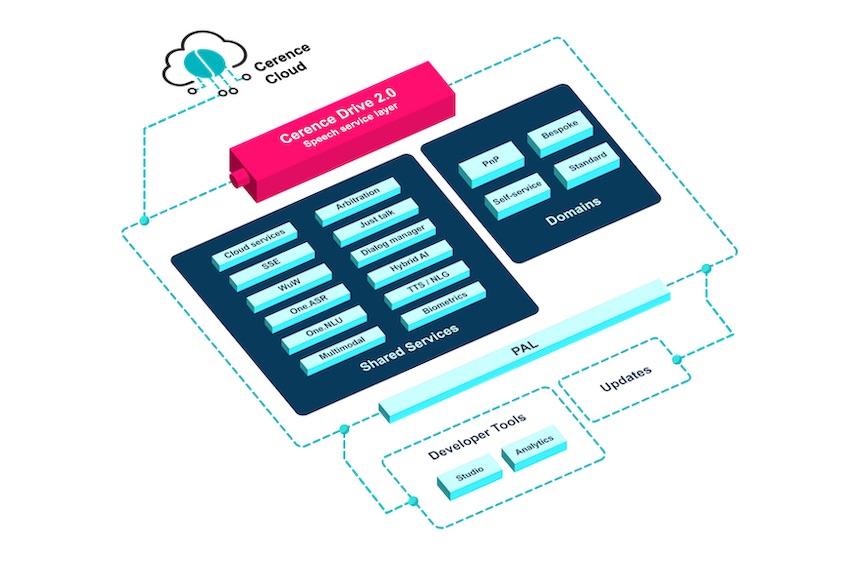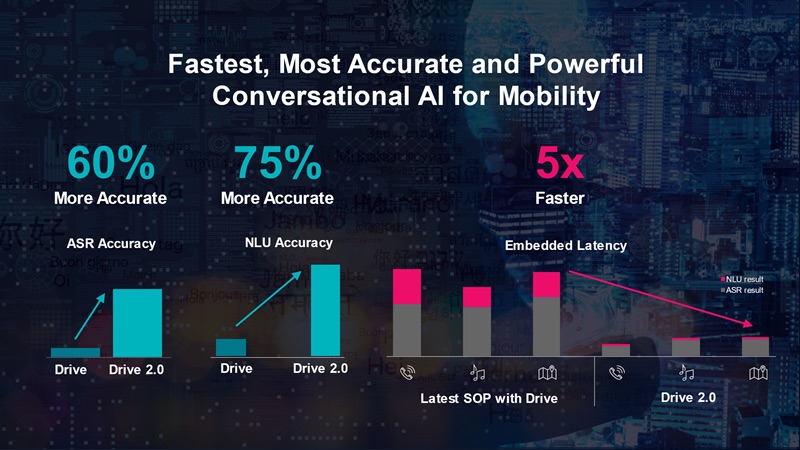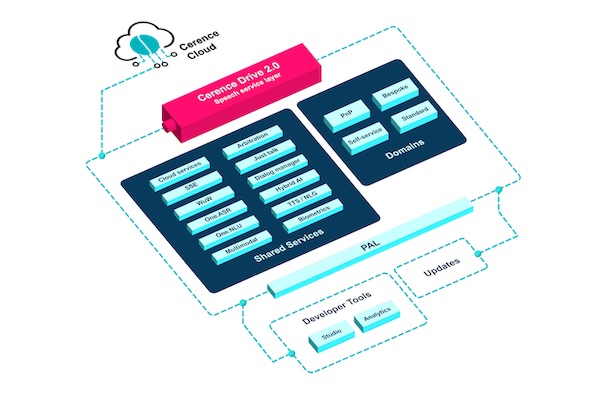Cerence Announces Drive 2.0 Release, New Cloud Services, Updated SDK, Performance Improvements, and Differentiation from Other Assistants

Cerence today announced its new Drive 2.0 solution for deploying virtual assistant and AI technology within cars. The company says it is more accurate, faster, and has more services in more languages than any competing offering for automakers. Udo Haiber, Cerence SVP of R&D and services, said during a live presentation that some customers have already begun implementing Cerence Drive 2.0 features and they will be available in cars as soon the end of the year.
The Cerence Drive 2.0 solution is the result of a year-long effort to rearchitect the company’s software into a single cohesive solution for automakers. In the past, it was sometimes hard to determine how all of Cerence’s technology options fit together into a single vision for how drivers will interact with their cars using AI. Cerence cleared that up today. Drive 2.0 shows how all of the embedded solutions work together in the car as well as how cloud services are accessed to augment the experience.
Updates to Cerence Studio, the development environment for Drive 2.0 customers, also show how automakers will be able to more easily implement their preferred AI services and create custom features of their own. In addition, Cerence Studio will now enable developers to directly import existing Alexa skills and Google Actions for use with the embedded assistant. “This eliminates the time that was previously needed to write new domains,” said Stefan Ortmanns, an executive vice president that oversees Cerence’s product portfolio.
What We Want of Voice Assistants While Driving
The event went into detail on more than a dozen features of Drive 2.0, some of which has previously been announced and others that were entirely new. Haiber was clear that Cerence is building custom assistants for automakers and not the general-purpose assistants offered by companies such as Amazon and Google. The company also released a video designed to highlight some of those differences in terms of voice assistant capabilities. It shows that there are several common voice interactive use cases that Apple Siri, Amazon Alexa, Google Assistant, and Cerence can all perform. The video below then goes on to show use cases that the general purpose solutions cannot execute such as “find a coffee shop nearby but not Starbucks” or “find parking.” The emphasis on the differences was largely around compound commands and driving-specific use cases. However, the deployment of custom wake words and eliminating the need wake words were also addressed.
Differentiating from the Pack
It is important for Cerence to distinguish these capability differences for its primary audience of automotive OEMs. Cerence and its forebearer, Nuance Automotive, have been dominant in voice interactive solutions for automakers for two decades. However, the rise of new voice assistant technologies has threatened Cerence’s stranglehold on this market. Players such as SoundHound have challenged it directly with solutions designed for the driving experience. Amazon has recently followed suit with its Alexa Auto offering.
With that said, the arguably bigger impact has come from Apple and Google. The increased use of Siri and Google Assistant through Apple CarPlay and Android Auto respectively has displaced some consumer use of embedded voice assistants provided by the automakers, many of which employ Cerence technology. Cerence has continued to be a favorite of automakers because it works well without cloud connectivity (something both Siri and Google Assistant require) and supports languages around the globe while also enabling the OEMs to maintain control over the user experience and data. The challenge the company faces is really more about consumer behavior. Will consumers take their smartphone-centric habits from outside the car into the driving experience or will they use a hybrid approach of smartphones plus embedded car solution to take advantage of enhanced features?
The video above and the long list of new edge-based and cloud services announced today go well beyond anything that CarPlay or Android Auto offer and also beyond Alexa Auto’s features. At the same time, Cerence is positioning itself as friendly to the integration with popular consumer assistants so users can have access to both while driving. In that way, today’s announcements serve two purposes. The first is to demonstrate to automakers clear differentiation from alternative technology suppliers in terms of technology and feature scope. The second is to show these same OEMs that Cerence enables them to make a strong case to consumers that they should use the embedded assistants within their cars because they offer unique services they can’t simply get from their smartphones while driving.
Cerence Connect Cloud Features
Cerence’s history has been voice technology for in-car control features. Many of these were on display today, but the company has also been working on a series of new features that take advantage of cloud services. Cerence CTO Prateek Kathpal outlined several of these features in detail including:
- Cerence Extend – Direct access to smartphone apps from the Cerence voice assistant deployed in the infotainment head unit. This feature enables users to access smartphone apps by voice without the need to invoke Siri or Google Assistant. The OEM-branded assistant can access them directly.
- Cerence Connect – Direct access to smart home devices from the Cerence voice assistant deployed in the infotainment head unit. Turn on the lights, adjust the heat, and control other devices from a variety of smart home product makers.
- Cerence Browse – Ask general questions to the embedded voice assistant and receive answers video audio response from Wikipedia and other web-based information hubs.
- Cerence Tour Guide – Take an audio-guided tour of an area with the embedded voice assistant providing both the navigation route for the drive as well as information about points of interest as you pass by. The example provided was Mulholland Drive in L.A. to the Griffith Observatory. It is not clear how many of these tours are available.
- Cerence Look – Recently announced as a new feature of a forthcoming Mercedes model, this enables drivers to look at building or point of interest while driving and get information about it by saying something as obscure as, “what is that?” Eye-tracking technology combined with GPS navigation, voice recognition, and point of interest knowledge bases enable a new way to find out information about your immediate environment while driving.
Improved Performance
Another focus of the presentation was a discussion about how Cerence Drive 2.0 also includes improved performance. Udo Haiber commented that the automated speech recognition was 60% more accurate and the natural language understanding (NLU) was 75% more accurate than the previous generation of the company’s solution. In addition, the latency for connecting phone calls, retrieving entertainment, and initiating navigation was dramatically improved.

Sunny Madra, vice president of Ford X, also joined the presentation for a conversation with Richard Mack, chief marketing officer for Cerence. “It’s wonderful to see the product announcements because the customers are actually looking for that seamless connection between their smart home ecosystems and their vehicles…We’re seeing that as almost a primary decision factor around the vehicle because it’s so important that the investment you make in your smart home … caries into your vehicle,” Madra said.
He added “We’ve seen previous today … these fractured or fragmented ecosystems. And, what you guys are really bringing to the market today is the ability to continue to use that same ecosystem…It’s really important that the platform in the vehicle support multiple assistants…The customer expectation is so broad now because of the smartphone world that they expect to have world-class services in every area, whether they’re listening to music, they’re connecting with their smart home or just using it for POI searches. ” He went on to discuss his interest in Cerence’s model for supporting access to multiple assistants simultaneously along with the breadth of features.
You should expect to see many of these features rolling out in new car models over the next two years. Cerence said it will maintain them going forward with over-the-air (OTA) updates. This will eliminate past issues with car model technology quickly getting out-of-date.
Cerence had a very strong year financially despite global economic headwinds in the automotive sector. As the competition for in-car voice assistant technology intensifies, the Drive 2.0 announcements will be critical to keep that momentum going and appear to be very well-timed.
Follow @bretkinsella Follow @voicebotai
Mercedes-Benz Will Keep Using Cerence to Run Revamped MBUX Virtual Assistant
Cerence Look Adds Visual AI to Automotive Virtual Assistants









